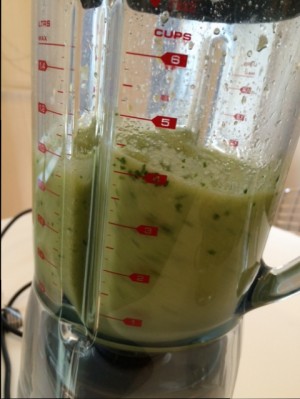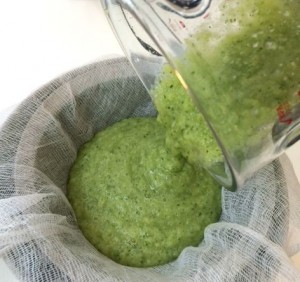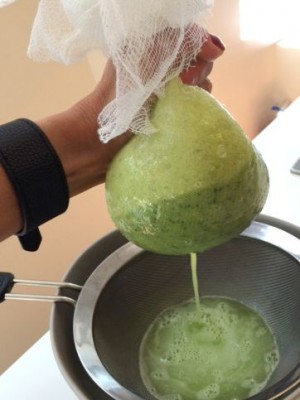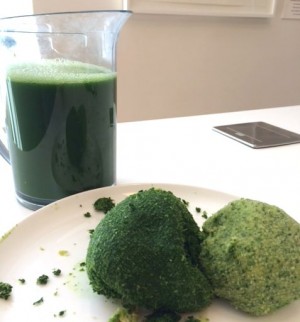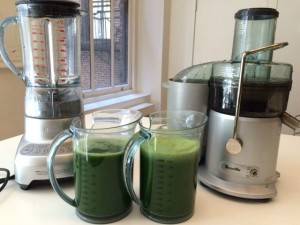We Tried It: Juicing Without a Juicer
By Christine Frietchen
Every few days, we get this question on our Reboot with Joe Facebook page: “Do I really need a juicer to make juice?”
Yes–you can get juice from produce without a juicer. But as I found, you need patience, a lot of time, and don’t wear your Sunday clothes.
I’ve become a little obsessed with juicing-for-less since I started working here at Reboot With Joe (see all my budget juicing articles here), so I’ve been keen to give this a try.
What you need:
- Blender
- Fine-mesh strainer
- Big bowl
- Cheesecloth
It’s important to note that you cannot juice in the exact same way with a blender alone (Read more in Juicing vs Blending). With the method I tried, the blender is merely the first step of several. A true juicer, of course, does all these manual steps at once.
I decided to make Joe’s Mean Green Juice – our most popular recipe – to test the process. I also made the Mean Green using a juicer (the $149 Breville Juice Fountain Plus) to test juice yield between the two methods. I was careful to use the same size and weight of produce for each method for a clean comparison.
Here’s the recipe:
- 1 cucumber
- 4 celery stalks
- 2 apples
- 8 leaves kale
- 1/2 lemon
- 1 in (2.5 cm) piece of ginger
Blender + Strainer + Cheesecloth Method
The basic steps are simple:
- Puree all ingredients
I needed to blend in batches — three times — to get all my produce pureed. I also needed to add a small amount of water just to get the blender going, about 1/4 cup to each batch. (To keep things fair, I added the same amount of water to my juicer-juice.)
- Strain the blended ingredients.
Place a fine-mesh strainer over a bowl, and line the strainer with cheesecloth. (You want to use a large enough piece that you’ll be able to gather the corners into a bag.) Pour the blended ingredients over the cheesecloth/strainer, allowing the liquid to start to collect in the bowl.
- Squeeze out additional liquid.
When your strainer/cheesecloth fills with pulp, gather the corners of the cheesecloth and twist, squeezing out as much juice as you can. You might want to put on an apron: Aggressive squeezing resulted in kale juice in my eyeball and on my white t-shirt!
- Continue with remaining blended ingredients.
I needed to empty out my cheesecloth before squeezing the remaining pulp. As you can see, I put some muscle into it! I was pretty impressed by the compactness of my pulp balls.
The Results: Blending/Straining Vs Juicing
I was surprised that the juice yield between the two methods was identical; I expected the manual method to come up short. I really was diligent about squeezing out as much juice as I could. And in the end, I think my leftover pulp was about the same too.
I did a little office taste test to see if there was any flavor difference, and all agreed that the juices tasted the same, but there was a slight difference in texture. My four testers all said the blender/strainer juice seemed more clear, while the juicer version had a little more texture.
The deciding factor: Time
I spent 25 minutes making juice with the blender and strainer, not including cleanup. The juicer did the same job in about 2 minutes.
If you have lots of time on your hands, the blender/strainer method certainly works, at least for once-in-a-while juicing, but I can’t see doing it several times a day for a Reboot. There was something pleasurable about squeezing the juice by hand–the same satisfaction you get from kneading bread or gardening, the feeling of getting your hands messy. But all else being equal, the juicer was more efficient at the same job.
If you’re not ready to spring for a juicer, you could certainly try this method just to get your juicing feet wet, but I think after a few days, most people will be shopping for a juicer. Check out my money-saving article on buying a budget juicer.
Have you tried the blending/straining method? What are your thoughts?
